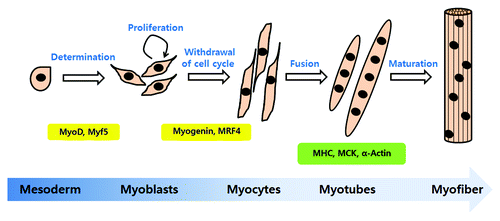Figures & data
Figure 1. The steps of myogenic differentiation. Myoblasts originate from the mesoderm and are converted to skeletal muscle lineage myoblasts after MyoD and Myf5 expression. First, myoblasts enter the cell cycle and proliferate. When the growth factor or mitogen from myoblast cultures is withdrawn, proliferating cells exit from the cell cycle and initiate differentiation. Myogenin and MRF4 are involved in the initiation of differentiation. In this step, myoblasts changed to an elongated shape and are called myocytes. Myocytes fuse with neighboring cells into multinucleated myotubes. The multinucleated myotubes express the muscle specific proteins, MHC (myosin heavy chain), muscle creatine kinase (MCK) and α-actin. The mature form of myotubes is turned to myofiber.
